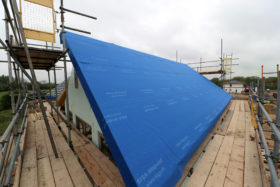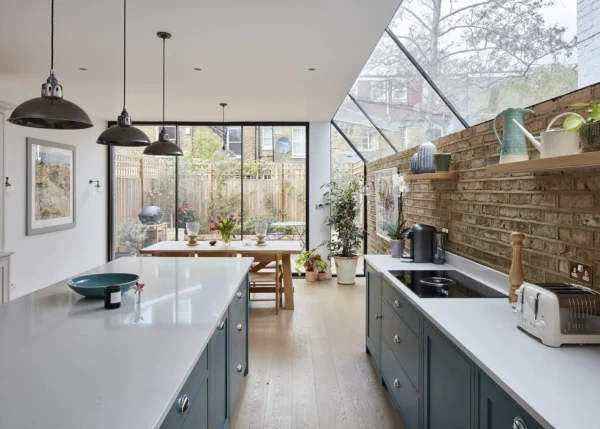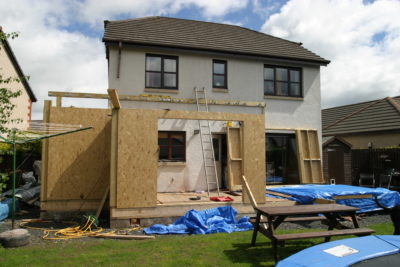Maximise Your Self Build Mortgage Borrowing Power
While some are lucky enough to be able to fund a project without borrowing, for most of us, a suitable mortgage is a must.
But the high street banks don’t tend to be set up for the unique requirements of a live build that’s changing in value as it gets constructed.
Thankfully, specific self build mortgages are available. But how can you access them and improve your chances of being accepted?
What are self build mortgages?
When you start exploring the market, you’ll quickly realise there are two basic types of mortgage for self builders; those that lend you money in arrears (ie after works have progressed on site); and those that give you it upfront and ahead of the works being started.
Both will almost always lend in stages as the project unfolds and both are typically capped at a maximum contribution of around 70%-85% of the predicted end value of the project, otherwise known as the loan-to-value (LTV) ratio.
With an arrears mortgage, when you reach one of your predetermined key stages for a payment release (such as the completion of the roof structure and covering) you make your request to your lender to access the respective tranche of funds.
The lender then sends out a valuer, who determines how much additional value there now
is on site, against which the lender can make suitable payment.
If the difference between the new value and the last one is, say, £40,000, then at an LTV of 80%, your stage payment release could be as much as £32,000.
With the advance stage payment mortgage, which was invented by BuildStore, your cash flow needs are interrogated in detail before the project even starts.
This way, the right amount of money can be made available to meet your payment commitments as the work progresses.
The project is properly costed, the release stages calculated, your borrowing facility assessed against the cash you already have available and a detailed cash flow statement is prepared.
Why’s this important? Well, payments to suppliers and contractors may be due ahead of the incremental increases in building value. So if your agreement pays out in arrears, you’d need to foot the bill out of your own cash reserves and wait for the lender to replenish your funds.
Build It Directory: Finance Specialists
The advance stage payment route removes this issue for the self builder – instead, the lender takes on a funding gap (the level of exposure it temporarily takes on until the project is complete). This gap is secured by an insurance bond, so you’ll be a one-off indemnity fee for this kind of mortgage.
Arrears mortgages are more straightforward from the lender’s perspective, so there are more options available in this category, although the range of both arrears and advance solutions is growing (see page 123 for a list of current providers and products).
Advance stage lending is provided by a well selected panel of building societies – such as 2018 Build It Award winner, Newcastle Building Society – coordinated and managed through Buildstore Mortgage Services.
What self build lenders want
The Mortgage Market Review (MMR), dating back to 2009 following the financial crisis, obligated lenders to tighten their criteria.
No longer could mortgages be offered based on earning multiples only – instead, a much more fundamental assessment became necessary to test real and practical affordability.
Mortgage application forms now include detailed questions about lifestyle as well as earnings, and look to see how each applicant disposes of their cash on a weekly, monthly and annual basis.
So, from a personal perspective, lenders ideally want applicants with appropriate incomes in relation to the sums being sought; excellent credit scores reflecting no known previous credit complications; along with well-managed weekly and monthly outgoings demonstrating strong skills in cash management
Step one, then, is to rationalise your financial situation to put yourself on the best footing.
Some lenders may have an issue with age, where proposed mortgage terms might stretch beyond intended retirement, but others understand that after the house is built the lending profile is likely to switch to something more appropriate.
For those who are self-employed, lenders need to see multiple years of earnings via submitted tax returns and, where appropriate, limited company filed accounts.
How mortgage lenders assess your project
Once you’ve passed the background checks, the rest of your application will be based upon the project profile. You’ll ultimately need to prepare a series of well-qualified answers under the following broad-brush headings:
1 Design & planning
While this might seem simple enough, often the plans will be tweaked, maybe more than once. You might apply for non-material minor amendments, or the project may have evolved through the specification and building control stages, meaning corrective drawings need to be resubmitted.
Your planning permission certificate will come with conditions, and one of these is almost always a listing of the drawings that have been approved.
Both you and your lender must be absolutely certain that the final working drawings are based upon this approved scheme and that all window and door positions, roof pitches etc are still in line with the referenced planning consent.
2 Specifications, building control & warranties
In order to have a project properly costed, you first need to choose your spec. The most influential element will be the construction type; ie masonry, timber frame, structural insulated panels (SIPs), insulating concrete formwork (ICF) etc.
This is the shell to which all other products will be fixed or integrated and some lenders may apply restrictions to certain chassis types and/or product combinations.
Almost all lenders are happy to work with timber frame, for instance, but not necessarily where significant timber cladding is being specified. Most providers have come across SIPs and ICF but it is not an automatic certainty that they will always lend on these more modern technologies.
If a lender appears hesitant, one thing that can often make a difference is support and written approval from your warranty provider as well as building control.
So as you evolve your preferred building specification, try to ensure all stakeholders having an opportunity to comment and/or ask for more details where necessary.
3 Detailed costings
With your spec finalised, you can assemble your costs and spending profile. Obviously, you’ll be getting all sorts of quotes along the way – but only when you have the final combination will you be able to get certainty over cost.
You’ll need to secure written quotes for supply and fix and to have satisfied yourself first, and your lender second, that all gaps and overlaps have been accounted for.
It’s perfectly fine to use provisional sums, for example for the kitchen, sanitaryware supply etc. But when doing so, be sure you put in a realistic level. Always ensure that your costing summary includes a contingency.
4 Build management
This is a big influencer on cost and lenders could be wary of people in full time paid positions who elect to self-project manage, especially where they have indicated that they are also to undertake some physical labour on site.
Any organised person willing to put in the time, effort and research can run a build – but it does involve a presence on site at times during the working week.
So if you’re planning to take this route and you have a day job, then look to bring someone into the building team who will act as a coordinator on site when you’re not there.
5 Domestic logistics
This category answers any potential challenge from your lender about where you are to live while the works are underway.
Popular options include your existing, unsold house (not subject to mortgage), rental accommodation, staying with relatives, or properly equipped (and costed) mobile homes on site.
The financial assumptions that go along with this should be transparent in your cost summary.
The mortgage application process
While the above may seem like a lot to do, all self builders who need a mortgage will have to successfully complete this exercise.
The results will define quite clearly which of the two basic mortgage types (arrears or advance) you’ll need to complement your cash flow requirements.
If you have already acquired your land, then a mortgage decision in principle (DIP) may be all you need to kickstart the design phase, which after all will take several months.
For those of you who need more certainty about the mortgage and overall affordability, assumptions will need to be made in stages two to five outlined above and plugged into your financial model.
The robustness of these assumptions will be tested by the lender, and the exercise may need to be repeated if you’ve not been realistic enough.
self build mortgages latest rates
Once the lender is happy with the quality of your submission, they’ll make an offer – which is then available for you to accept by taking your first draw-down. But don’t start the building work until you have had your offer confirmed and you are certain about how much money is being advanced.
For those of you who need mortgage funds to help with the land acquisition, the above process still needs to be followed, using the current planning permission on the site in question.
This is because the land with its consent is the only asset the lender is able to use as security. While the mortgage provider will accept that you may be intending to amend the plans, they’ll want to be reassured about your application and intentions regarding the site based upon the known existing consent.
As such, you’ll need to complete the process outlined above first, and there will then be a second round of refinement to your mortgage application once the new planning permission comes through.


































































































 Login/register to save Article for later
Login/register to save Article for later















